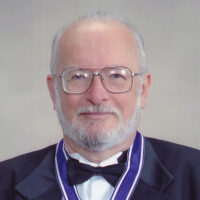
1994 Kyoto Prize Laureates
Biotechnology and Medical Technology
/ Chemist
1929 - 2007
Professor and Director, Biomedical Magnetic Resonance Laboratory, University of Illinois
1994
11 /11 Fri
Place:Kyoto International Conference Center
Application and Prospectives of Magnetic Resonance Imaging
1994
11 /12 Sat
13:00 - 17:30
Place:Kyoto International Conference Hall
A chemist who was the first to propose the basic principles of magnetic resonance imaging (MRI), an imaging diagnosis method widely applied in modern medicine. He confirmed experimentally the feasibility of MRI and laid the foundations for its improvement and development, and also developed many related technologies. Dr. Lauterbur has thus contributed immeasurably to clinical medicine.
*This field then was Field of Biotechnologies (including Medical Technologies).
In the category of Advanced Technology, which for 1994 focuses on the field of “Biotechnology including Medical Technology,” our laureate is Dr. Paul Christian Lauterbur.
Dr. Lauterbur was the first to propose the basic principle of MRI (Magnetic Resonance Imaging), an image diagnostic technique now widely used in the medical field and to experimentally verify its feasibility through experiments. Thus, he created the foundation for the advancement of MRI and also developed many related technologies.
Dr. Lauterbur conceived the NMR zeugmatography technology to encode positioning information on NMR signals using gradient magnetic fields and the image reconstruction algorithm (an image projection recovery method) which produce sectional data from projection data as made practical by CT scanning. He submitted his idea accompanied by phantom experimental data, in a paper entitled, “Image formation by induced local interactions,” to Nature in 1973, making this the world’s first publication of the innovative idea to create images out of special distribution of NMR signals. Based upon this paper by Dr. Lauterbur, many related methods were proposed, leading to clinical trials in 1982 and subsequent rapid development in MRI technology as we know it today.
MRI is non-invasive, is not affected by bones, and excels in contrasting soft tissues. As it captures information on human body’s soft tissue in its essential three-dimensional format, it allows applications of various measurement methods. This makes it invaluable not only as an early diagnosis of cancer, but imaging of cerebral activities, blood flow and other phenomena that are accompanied by chemical changes.
It is certain that it will play an increasingly important role in the already spectacularly progressing areas of research in brain function analysis.
Dr. Lauterbur has continued to contribute to the development of MRI by publishing papers on such topics as selective excitation method, chemical shift imaging, flow rate measurement, image formation by paramagnetic metallic salts, three-dimensional MRI, and surface coil imaging. More recently, he has been engaged in research to improve NMR microscope and brain research using NMR. Prior to proposing MRI, he pioneered the use of 13C Spectroscopy and his Achievements in this area are also numerous.
Today, MRI continues to advance dramatically, based upon the basic principles laid down by Dr. Lauterbur 20 years ago, and reinforced by the subsequent discovery of many constituent technologies and by the efforts of many technical expert.
Dr. Lauterbur’s contribution to medicine through his work on MRI is immense, and he is the most befitting laureate for the 10th Annual Kyoto Prize in Advanced Technology.
Profile is at the time of the award.